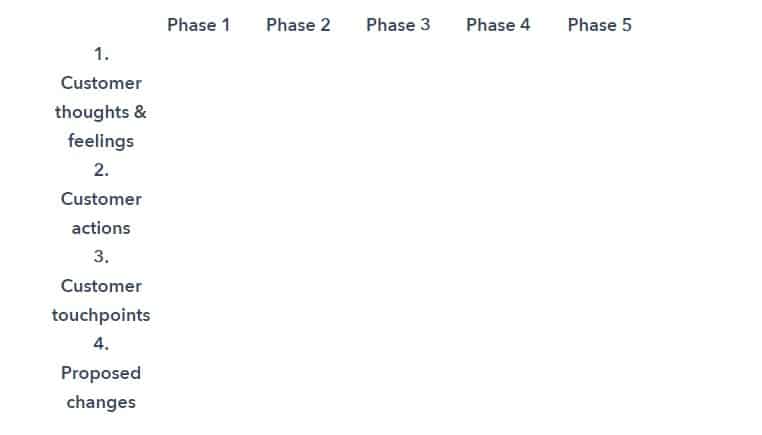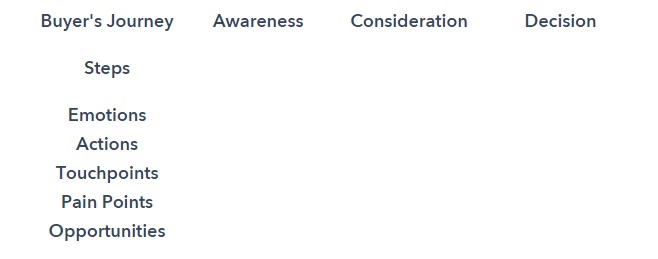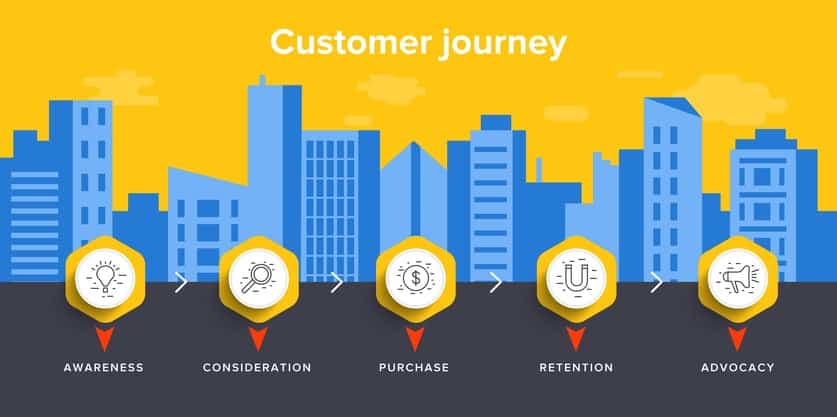Patient journey maps have become the favourite tool to approach customers’ experience, however, many dental practices find it quite intimidating to implement within their dental marketing strategy. Nevertheless, do not be afraid as this is something that anybody is able to do.
This brief post has the aim to introduce the concept of patient journey mapping to you, provide you with plenty of benefits and reasons to convince you from today to create your own patient journey map for your dental practice and how to create it. In addition, to make your life easier I will provide you with some general tips that can help you get more inspired, and even some templates to use. So, let’s get started!
Firstly, what is the patient journey map? A patient journey map is a visual representation of every single experience that your clients have with your business. Creating a patient map helps businesses to understand their patients by stepping into their shoes and to identify pain points and gain points.
Your patients meet your dental practice in different ways so the more you get into detail and the more touchpoints (single encounters) you are able to identify, the better. On the other hand, do not get upset if you don’t come up with may ideas or you don’t go into much detail at the start. Consider that representing 100% of the real experience is an almost impossible task.
Benefits of Patient Journey Mapping
Secondly, which are the benefits/advantages that patient journey mapping can bring to your dental practice? Here you have a list
- A better understanding of your patients.
- Improving patient experience: this brings you the possibility of fixing pain points patients might encounter. How can you do this? By making sure you understand how they navigate across the touchpoints along the journey.
- Identifying key service issues: when you create the whole process of patients’ experience on paper/online you will be able to identify where problems might take place. For instance, you may realise that patients visit your website but leave after 10 seconds. This might suggest your website does not load quick enough.
- Defining future goals: once you have a rough idea of the areas that need to be improved or changed, you can set goals for your business.
- Reducing costs: businesses that make use of patient journey mapping are also able to reduce costs.
- Positive word of mouth: especially if your dental practice is an SME, you are aware of how reviews and feedback can improve or harm your business. Therefore, improving the overall patient experience translates into more satisfied customers who are more willing to share their positive experience with others through social media or make recommendations to family and colleagues. Tip: here you can learn more about how to increase your dental practice reviews
- Escalating through the Customer Loyalty Ladder: this point is what I’m going to explain next.
The Customer Loyalty Ladder
A customer loyalty ladder is a tool that permits the classification of the customers of an organisation into five different categories regarding the customers’ level of engagement with the organisation. It’s as easy as that. The five different categories which people are classified into are suspects, prospects, customers, clients and advocates.
- Suspects: this category includes potential customers for a business. They might be aware of the marketing efforts of the business but are not currently doing business with it.
- Prospects: they are in serious consideration of buying products or services of the organisation, so the organisation must treat them cordially and solve any enquiries.
- Customers: they have bought products/services from the organisation for the first time. The task of the organisation is to offer them all possible after-sales assistance and try to engage with them further.
- Clients: they repetitively do business with the organisation. In addition, they are willing to foster that engagement in the future. This category is important because, if well engaged, clients can help boost business.
- Advocates: they do the same as clients but also recommend the business to their own circle. Remember what we mentioned before about word of mouth? These are the most valuable and you should treat them royally.
What is the conclusion that we can extract from reviewing the customer loyalty ladder then? That it helps businesses to plan their engagement strategies in a clever way, so customers are encouraged to climb up the ladder.
Also, it is assumed that attracting new customers is between 4 and 6 times costlier than doing business with your existing ones. Thus, this relates to the benefit of saving costs once more and improving the overall experience.
How to create a patient journey mapping?
First approach
- Define clear objectives: firstly you need to define what goals are you directing this map towards. After you have to create buyer personas. Buyer personas are fictitious representations of customers that include all demographic and psychographic factors that represent your average patient.
- Define your business’ buyer personas and their goals: if you are not sure how to approach this step, there are amazing tools out there like Audiense that give you insights about your patients such as age, income, job position, where are they based, what they like, etc, for free.

Second Approach
- List all touchpoints that you can think of: customer touchpoints are all the interactions between your brand and the customers. The number of touchpoints is endless. For instance, it can go from how easy it is for them to navigate to your website, to the cleanliness of your facilities or the relationship price/quality of your products and services.
- Regarding your website, touchpoints are all the places that your patients can interact with you. This step is essential in order to find out what actions they are carrying out. Lastly, as I just mentioned, touchpoints do not only mean your website but think of all the ways in which patients might come across you online. That can go from social media channels to email newsletters or even third-party reviews on Google or other platforms.
- Identify Pain Points: they are specific problems that your patients might be experiencing. Just think of them as problems, plain and simple. Although many of them may be experiencing the same or similar issues, the root of the problem can be diverse. The reason behind this is that pain points are subjective. One of the most effective ways to identify these pain points is through conducting qualitative research. In other words, really listen to your patients and to what they have to say.
- Put yourself in the patients’ shoes: surely the easiest approach to identify touchpoints and determine which are gain points or pain points is by starting the patient journey yourself as if you were him or her.
- Make the necessary changes and adjustments: address directly to your pain points because, no matter how small the changes are, they will be effective as you are not blindly making changes with the hope that things magically improve.
Keep Improving It
Last but not least, take your patient journey map as a constant and long-term activity. Especially when your business expands, or your website improves, you will attract new patients that might have a different profile and new touchpoints will arise.
Then, review it as many times as you need, involve your employees and everyone working for your dental practice. Maybe they have ideas you were taking for granted or missing out.
Some Tips For You
Now you know what a patient journey map is, what the main advantages and benefits are, and a simple guideline to make your own. Now I am going to give you some ideas regarding your online presence. You can steal them for your own patient journey map. Or they could serve as a source of inspiration.
For starters, the very first contact that someone looking for dental practices within the Manchester area may have with your company is the fact of appearing on the SERPs (Search Engine Result Pages). Unless they are searching for your specific dental practice if your business does not manage to appear at least within the ten first results, forget about it. Therefore, having good positioning in search engines such as Google is a must.
Let’s suppose someone has an appointment with you and they are trying to find directions to get there. Have you positioned your dental practice in Google Maps and provided accurate information about opening times, address, etc?
What Is Next?
Right, so now the patient has decided he/she wants to access your website. One touchpoint is the time your website takes to load. If they spend ages trying to go to your website, that is a potential patient who is unlikely to return. Another touchpoint could be the layout of the information inside the website.
Do you have specific categories regarding services, contact, general information about your business or is it all mixed and unorganised? Is it a visually pleasing website and is navigation easy and intuitive or is it a nightmare?
Another possible situation is that that this potential patient has decided to book an appointment, they like your website, your dental practice seems to be nearby, and they want to contact you. Probably he/she will be able to find all the contact details on the website (I hope so). But then, how long do you take to answer the phone? Or, do you answer the calls at all? I am sure you get the point of the exercise.
Now try to identify your own touchpoints and decide whether they are gain points or they are pain points that could be improved or changed.
Free Templates
On the Internet you will be able to find a million templates to create your personalised patient journey map, however, here I leave a few examples. Feel free to take them as they are or make the changes you consider.


Conclusion
In conclusion, whilst creating a patient journey map can be daunting at the start, it is worth considering building one due to the number of benefits and advantages such as reducing costs in the long-term, increase patients loyalty and a better understanding of their needs. Doing this will give you a massive advantage over competitors as due to a wide range of reasons, small and medium businesses often ignore this tool.
If you wish to learn more, why not booking a free consultation with us now? You can give us a call on 0330 133 0635 or, if you prefer, fill in the following form.

